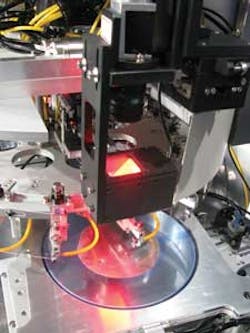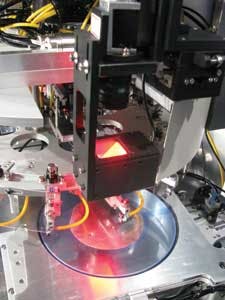SEMICONDUCTOR INSPECTION: Pick and place machine integrates real-time I/O
Today's semiconductor industry demands systems that can process and fabricate large numbers of devices at high-speed. This is especially true in the early stages of IC fabrication where semiconductor wafers must be inspected, diced, placed on lead frames and wire bonded. At every stage of this process, vision systems play an important role.
After wafers are manufactured, for example, they must be first inspected for defects before being mounted to a backing tape and diced with a wafer saw. After these wafers have been diced, they must then be placed onto a lead frame to which the IC can then be later electrically bonded.
To perform this die attachment effectively, each individual IC must be mounted onto the lead frame using a high-speed pick and place machine. Recognizing that this process must be performed at high-speed, engineers at Master Machinery (Tucheng City, Taiwan; www.mmcorp.com.tw) have developed a pick and place machine capable of placing up to 20,000 ICs per hour into lead frames.
To perform this task automatically, diced wafers are first placed onto a platen that can be moved in the x,y direction as well as rotated. Illuminated by axial diffuse lighting, images of the wafers are then captured by a single acA2500 GigE camera from Basler (Ahrensburg, Germany; www.baslerweb.com) and transferred to a host PC.
To isolate specific ICs within the field of view, Master Machinery used the Vision Development Module from National Instruments (Austin, TX; USA; www.ni.com). Once isolated, individual die must be vacuum picked from the platen. To accomplish this, vacuum picking heads are placed on a rotating table that moves over the wafer.
To properly position the picking head over the individual die, the platen holding the wafer is moved in x,y directions and rotated according to the co-ordinates of the die returned from the vision system. After the picking head selects the die, the rotating table is indexed and the process repeated for successive picking heads.
To place these die, a lead frame is placed on a platen diametrically opposite the platen containing the diced wafers. To position the die in this lead frame, the frame is again illuminated by co-axial diffuse illumination and an image of the lead frame captured with a second Basler aca2500 GigE camera. Images of the lead frame are then transferred to the PC and the correct placement position determined using the Vision Development Module software. Once again, the placement derived using the software is used to move the platen containing the lead frame into the correct position for IC placement. As the vacuum head is indexed over this position, the IC is then placed onto the lead carrier.
According to Kennes Wang of Master Machinery, one of the most important aspects of the system's design was integrating the machine vision and servo motion control system since, if accurate synchronization in the pick and place process was not achieved, die could be damaged. To ensure this accuracy, multiple brushless servo EtherCAT drives from Kollmorgen (Radford, VA; USA; www.kollmorgen.com) were used to control the motion of the platen containing the die, the platen holding the lead frame and the indexing table.
As the correct positional information is determined by the imaging system for die picking and placing onto the lead frame, the data is transferred to an NI cRIO-9068 CompactRIO system. The controller integrates Xilinx's Zynq-7020 SoC that combines a dual-core ARM Cortex-A9 processor and Xilinx 7 Series FPGA is then used to control the EtherCAT drives. According to Wang, the combination of the cRIO-9068 controller and Kollmorgen motor drives under control of LabVIEW NI SoftMotion software allowed Master Machinery to meet the 20,000 parts per minute throughput required.
Vision Systems Articles Archives

